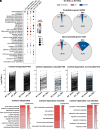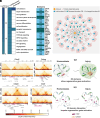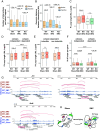Three-dimensional chromatin mapping of sensory neurons reveals that promoter-enhancer looping is required for axonal regeneration
- PMID: 39254997
- PMCID: PMC11420198
- DOI: 10.1073/pnas.2402518121
Three-dimensional chromatin mapping of sensory neurons reveals that promoter-enhancer looping is required for axonal regeneration
Abstract
The in vivo three-dimensional genomic architecture of adult mature neurons at homeostasis and after medically relevant perturbations such as axonal injury remains elusive. Here, we address this knowledge gap by mapping the three-dimensional chromatin architecture and gene expression program at homeostasis and after sciatic nerve injury in wild-type and cohesin-deficient mouse sensory dorsal root ganglia neurons via combinatorial Hi-C, promoter-capture Hi-C, CUT&Tag for H3K27ac and RNA-seq. We find that genes involved in axonal regeneration form long-range, complex chromatin loops, and that cohesin is required for the full induction of the regenerative transcriptional program. Importantly, loss of cohesin results in disruption of chromatin architecture and severely impaired nerve regeneration. Complex enhancer-promoter loops are also enriched in the human fetal cortical plate, where the axonal growth potential is highest, and are lost in mature adult neurons. Together, these data provide an original three-dimensional chromatin map of adult sensory neurons in vivo and demonstrate a role for cohesin-dependent long-range promoter interactions in nerve regeneration.
Keywords: cohesin; nerve regeneration; promoter loops; regeneration program; three-dimensional chromatin architecture.
Conflict of interest statement
Competing interests statement:The authors declare no competing interest.
Figures






Update of
-
Three-dimensional chromatin mapping of sensory neurons reveals that cohesin-dependent genomic domains are required for axonal regeneration.bioRxiv [Preprint]. 2024 Jun 9:2024.06.09.597974. doi: 10.1101/2024.06.09.597974. bioRxiv. 2024. Update in: Proc Natl Acad Sci U S A. 2024 Sep 17;121(38):e2402518121. doi: 10.1073/pnas.2402518121. PMID: 38895406 Free PMC article. Updated. Preprint.
References
-
- Beagrie R. A., Pombo A., Gene activation by metazoan enhancers: Diverse mechanisms stimulate distinct steps of transcription. BioEssays: News and reviews in molecular. Cell. Dev. Biol. 38, 881–893 (2016). - PubMed
MeSH terms
Substances
Grants and funding
LinkOut - more resources
Full Text Sources
Molecular Biology Databases
Miscellaneous

